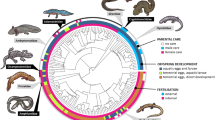Abstract
THE study of the newly discovered recent member of the Cambro-Silurian mollusc group Monoplacophora has caused me to extend investigations also to animals other than molluscs of the early Cambrian fauna. Then, I was struck by the appearance of some Olenellid Trilobites figured by Walcott1, showing additional segments behind what usually forms the long spine of the last segment (Fig. 1).
This is a preview of subscription content, access via your institution
Access options
Subscribe to this journal
Receive 51 print issues and online access
$199.00 per year
only $3.90 per issue
Buy this article
- Purchase on Springer Link
- Instant access to full article PDF
Prices may be subject to local taxes which are calculated during checkout
Similar content being viewed by others
References
Walcott, C. D., Smithsonian Misc. Coll., 53, No. 6 (1910).
Malaquin, A., “Recherches sur les Syllidiens”, Mém. Soc. Sci. Arts, Lille (1893).
Störmer, L., “Traité de Zool.”, 6, 159 (1949).
Snodgrass, R. E., “Textbook of Arthropod Anatomy” (Ithaca, N.Y., 1952).
Burling, L. D., Ottawa Naturalist, 30 (1916).
Raw, F., J. Palaeont., 31 (1957).
Author information
Authors and Affiliations
Rights and permissions
About this article
Cite this article
LEMCHE, H. Supposed Asexual Reproduction in Trilobites. Nature 180, 801–802 (1957). https://doi.org/10.1038/180801a0
Issue Date:
DOI: https://doi.org/10.1038/180801a0
Comments
By submitting a comment you agree to abide by our Terms and Community Guidelines. If you find something abusive or that does not comply with our terms or guidelines please flag it as inappropriate.



